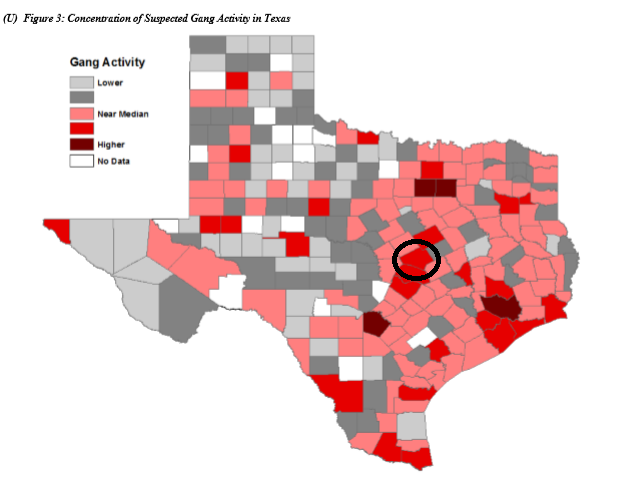Gang activity is high in the Killeen-Temple-Fort Hood area, according to a 62-page report by the Texas Department of Public Safety.
The Gangster Disciples, ranked as a "Tier 3 gang" in terms of the gang's "threat" statewide, showed higher levels of activity centralized in Bell County.
In 2005, a Fort Hood soldier was found guilty of two aggravated robberies and sentenced 99 years in prison. The soldier, Jerome Smith, was recognized as a leader of the Gangster Disciples in the Fort Hood area, according to law enforcement. In November 2003, investigators said Smith sent three of his gang members to a gas station on Veterans Memorial Boulevard in Killeen. The members followed the store owner to his home in Harker Heights, pistol whipped him, and stole nearly $300. They added Smith sent two members to a convenience Store on 10th Street, where they stole $110.
Figure 3 of the report shows the concentration of suspected gang activity in Texas by county, and Bell County is marked with the second-highest ranking on the spectrum -- a bright red color.

Nationally, the gang is active in more than two-dozen states, according to U.S. Department of Justice.
In the DPS report, The Texas Joint Crime Information Center used a threat assessment matrix to compare and evaluate the threat posed by individual gangs at a statewide level.
This matrix conducted by TJCIC consisted of 11 factors used in determining each identified gang’s "threat potential." The factors were rated by using a weighted, point-based system to achieve a composite score. This score provides a measurement of the overall threat level of each gang.
The 11 factors included in the TJCIC threat assessment matrix were as follows:
- Relationship with Cartels: Examines the degree to which a gang is connected to Mexico-based drug cartels. Gangs are assessed as having no or limited relationships, relationships based on third-party contacts, or as having direct contacts.
- Transnational Criminal Activity: Considers whether a gang has transnational criminal connections, as well as whether a gang’s criminal activity has spread into transnational territory.
- Level of Criminal Activity: Rates the type and frequency of crimes perpetrated by the gang. Crimes are rated on a scale covering a range of offenses, from misdemeanors to various levels of felonies.
- Level of Violence: Assesses the overall level of violence perpetrated by the gang in its criminal activity. It ranges from generally non-violent offenses, such as money laundering, to crimes involving extreme violence, such as torture and murder.
- Prevalence throughout Texas: Determines the extent to which a gang is active throughout the state. The geographic reach of some gangs is limited to specific cities or regions of Texas, while others are widespread across the state.
- Relationship with Other Gangs: Examines the nature of a gang’s alliances and influence with other gangs. This may involve limited and temporary contacts, formal alliances, or the direct oversight of some gangs by others.
- Total Strength: Assesses the known size of the gang, measured by the number of individuals confirmed by law enforcement and criminal justice agencies. This number is usually an underrepresentation of the true size of the gang since many members are unknown to law enforcement.
- Statewide Organizational Effectiveness: Examines the gang’s effectiveness in organizing members under its leadership across the state.
- Juvenile Membership: Considers the extent to which the gang recruits juveniles and is active in schools, as recruitment of minors is a unique threat.
- Threat to Law Enforcement: Considers the extent to which the gang represents a threat to law enforcement. Some gang members may only use violence to resist arrest or to flee from law enforcement, while others may actively target officers.
- Involvement in Human Smuggling and Trafficking: Examines the gang’s involvement in human smuggling and human trafficking activities, including the sex trafficking of juveniles.
Editor's note: The graphic provided by Texas DPS below represents the threat posed by gangs statewide and does not necessarily represent the greatest gang threat in any particular region.

Gangs which yield the highest scores are deemed the most significant and are classified as Tier 1, while other gangs with less significant scores are classified as Tier 2 and Tier 3.
TJCIC updates the rankings on an annual basis to ensure accurate assessments on gang threats statewide.
According to DPS, nearly 60 percent of identified prison gang members are serving sentences for "violent crimes," classified in the report as a crime in which a force of threat is extended onto another person.

The 59 percent of "violent crimes" were broken down into the following figures: robbery (23%), homicide (16%), assault (14%), and sexual assault (6%).
TDCJ reported drug-related offenses accounted for 13 percent of gang member incarcerations and added that an additional 13 percent of convictions were property-related (10% burglary, 2% theft/larceny, and 1% motor vehicle theft).
The History Channel produced a documentary on the Gangster Disciples gang.
The video can be viewed on YouTube:
The full DPS report can be found here.


